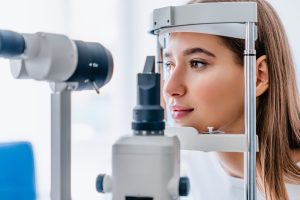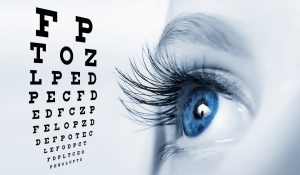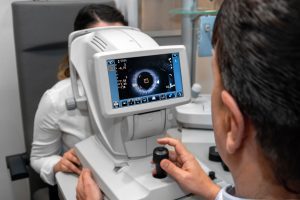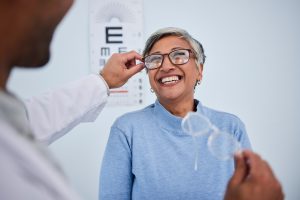What if a senior cannot make it to an eye exam in person?
Some optometrists offer tele-optometry services, which allow seniors to have an eye exam from the comfort of their own home using video conferencing technology.
In-person exams are much more effective
Remote appointments, such as tele-optometry services, have become increasingly popular due to advancements in technology and the need for greater accessibility in healthcare, especially during situations like the COVID-19 pandemic. While they offer undeniable advantages, particularly for seniors who might have mobility or transportation challenges, there are several reasons why in-person exams are preferable:
- Comprehensive Examination: In-person exams allow for a more thorough assessment. Many instruments used during a standard eye exam, like those for measuring intraocular pressure (important for glaucoma detection) or for a detailed inspection of the retina, can’t be replicated remotely.
- Accuracy: While tele-optometry can provide a general assessment of vision and eye health, the precision of measurements and observations is often better in a controlled clinical setting.
- Dilated Eye Exams: Certain conditions and diseases can be best detected when the pupils are dilated, allowing for a clearer view of the retina. This procedure isn’t feasible through remote appointments.
- Immediate Intervention: If a significant issue is detected during an in-person exam, immediate steps can be taken, whether it’s the prescription of medication, recommendation for further tests, or immediate referral to a specialist.
- Hands-on Adjustments: For those wearing or needing eyeglasses, in-person visits allow for immediate fittings, adjustments, and repairs.
- Personal Touch: There’s a human element in healthcare that can be especially reassuring for seniors. Being in the same room, having the opportunity to ask questions directly, and feeling the presence of a healthcare professional can make a difference in the patient’s comfort and understanding.
For seniors who cannot make it to an eye exam in person:
Tele-optometry becomes an invaluable service for those who can’t easily leave their homes due to mobility challenges, lack of transportation, or other concerns. While it may not replace the depth and accuracy of an in-person visit:
- Accessibility: It allows those who might otherwise skip an eye exam to get at least a basic assessment of their vision and eye health.
- Safety: For seniors who are at higher risk of complications from illnesses, reducing the need to travel or sit in waiting rooms can be beneficial.
- Preliminary Assessment: Even if a tele-optometry appointment detects a potential issue, it can serve as an early warning system, prompting a more urgent in-person visit when necessary.
- Convenience: Beyond health and safety, the simple convenience of not needing to travel, arrange transportation, or deal with external environments can make tele-optometry an attractive option for many seniors.
In conclusion, while remote appointments like tele-optometry can provide essential services and increase accessibility, they are not a replacement for in-person eye exams. Whenever possible, an in-person visit is preferable, but tele-optometry serves as a bridge, ensuring that more people, especially vulnerable populations like seniors, have some level of access to eye care.
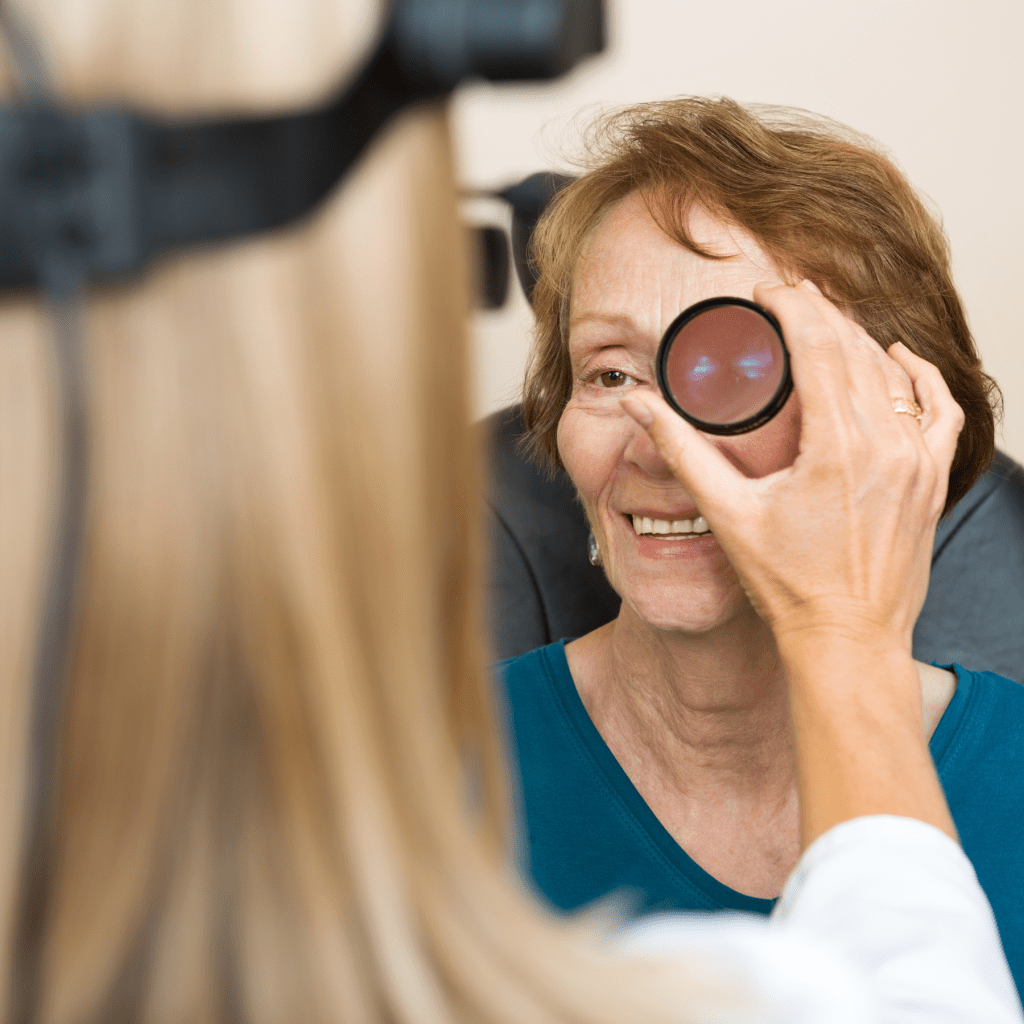
Related FAQs
Wearing glasses or contacts can indeed affect dry eye symptoms, but the impact varies. Glasses can help shield the eyes from environmental factors that exacerbate dry eye, such as wind or air conditioning. On the other hand, contact lenses can sometimes worsen dry eye symptoms by absorbing tear moisture or by causing irritation. Certain types of contact lenses are designed to be more breathable and retain moisture better, which may be suitable for people with dry eyes. It’s crucial to discuss with an eye care professional to find the most appropriate type of contact lens or glasses. Proper care and hygiene when using contacts, along with regular breaks from screen use, can help minimize dry eye symptoms.
Dry eye syndrome can be both a temporary condition and a chronic disease, depending on its cause and severity. Environmental factors or certain life situations, such as screen use or air travel can cause temporary dry eye. Chronic dry eye, on the other hand, may result from systemic diseases, medication side effects, or age-related changes in tear production. Management and treatment can alleviate symptoms, but chronic dry eye often requires ongoing therapy. It’s important to consult with an eye care professional for an accurate diagnosis and treatment plan. Understanding the underlying cause is key to determining whether dry eye syndrome will be a temporary issue or a chronic condition.
Yes, some specific exercises and therapies can help relieve dry eye symptoms. Blinking exercises, for example, can help improve meibomian gland function and tear film stability. Warm compresses applied to the eyes can also stimulate tear production and release oils from the glands in the eyelids. Gentle eyelid massages can help spread the oils evenly across the eye surface, reducing dryness. Using a humidifier to add moisture to the air and taking regular breaks to rest the eyes during screen time can also be beneficial. Newer technologies such as IPL (Intense Pulsed Light) and RF (Radio Frequency) are also becoming available. Consulting with an eye care professional for personalized advice on exercises and therapies is recommended.
Sleep plays a crucial role in managing dry eye syndrome. Poor sleep can lead to insufficient eye lubrication and worsening dry eye symptoms. During sleep, the eyes rejuvenate and produce the moisture needed for the next day. Good sleep hygiene practices can help ensure the eyes are well-rested and hydrated. It’s also important to avoid sleeping with any airflow directly hitting the face, as this can dry out the eyes. Establishing a regular, restful sleep schedule can significantly improve dry eye symptoms.
Indeed, some medications can exacerbate dry eye symptoms. Diuretics, antihistamines, antidepressants, and some blood pressure medications are known to reduce tear production or alter tear composition. It’s important to review any current medications with a healthcare provider to determine if they could be contributing to dry eye symptoms. Sometimes, alternative medications with fewer dry eye side effects can be prescribed. Always consult with a healthcare professional before making changes to medication regimens. Patients should also stay hydrated and consider using artificial tears if taking medications known to cause dryness.
Yes, it is quite common for dry eye symptoms to worsen in certain weather conditions. Dry, windy, or smoky environments can lead to increased tear evaporation, exacerbating symptoms. Conversely, high humidity can sometimes alleviate dry eye symptoms because the air is more saturated with moisture. Cold weather, especially during winter when indoor heaters are used, can also dry out the eyes. It’s advisable to use humidifiers in such conditions to maintain indoor humidity levels. Wearing wraparound glasses or protective eyewear outdoors can help shield eyes from harsh conditions.
West Edmonton Vision Clinic
Visit our vision clinic in central West Edmonton for comprehensive eye exams, contact lens fittings, glasses, and more. LL Eyecare Centre is dedicated to providing the highest quality optometric services and products to our patients. Our team of experienced optometrists is here to help you with all of your eye care needs. Schedule an appointment today!
Clinic Hours
Monday Closed
Tuesday 9:00-5:00
Wednesday 9:00-5:00
Thursday 9:00-5:00
Friday 9:00-5:00
Saturday 9:00-2:00
Closed Sunday / Holidays
